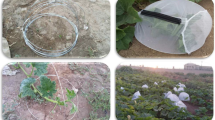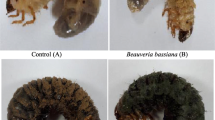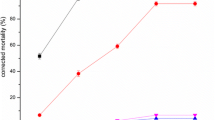Abstract
The entomopathogenic fungusPaecilomyces tenuipes was isolated from dead noctuid pupae the identification of which was impossible. Some remarks are given on the morphology of this fungus rarely occurring in our regions. Besides the conspicuous synnemata and the oblong oval conidia (6,0–10,0×2,0–3,8 μm from culture, 4,5–7,5 ×2,0–2,5 μm from infected larvae) brown coloured and thick-walled appressoria were formed on glass surfaces. Pathogenicity tests showed thatP. tenuipes can infect as well larvae ofMamestra brassicae andAgrotis segetum as pupae ofM. brassicae andAutographa gamma. The formation of a perfect state was never observed.
Zusammenfassung
Von eingegangenen, nicht mehr bestimmbaren Noctuiden-Puppen wurde ein in unseren Breiten seltener insekten-pathogener Pilz,Paecilomyces tenuipes, isoliert. Einige Beobachtungen zur Morphologie dieser Art werden angeführt. Neben den auffälligen Synnemata undden länglich-ovalen Konidien (6,0–10,0×2,0–3,8 μm vom Nährmedium, 4,5–7,5×2,0–2,5μm von infizierten Larven) bildetP. tenuipes auf Glasoberflächen braun gefärbte, dickwandige Appressorien. Versuche zur Ermittlung der Pathogenität ergaben, daß der Pilz Larven und Puppen verschiedener schädlicher Noctuiden-Arten zu infizieren vermag. Die Bildung einer Hauptfruchtform wurde in keinem Fall beobachtet.
Similar content being viewed by others
Literaturverzeichnis
Berisford, Y. C., Tsao, C. H., 1975: Appressoria formation byAspergillus parasiticus on bagworm cuticle. Ann. Ent. Soc. Am.68, 1111–1112.
Emmett, R. W., Parbery, D. G., 1975: Appressoria. Ann. Rev. Phytopathol.13, 147–167.
Fargues, J., Rodriguez, D., 1974: Étude préliminaire sur la pathogénicité pour les Noctuelles des champignons imparfaits (Deutéromycètes) entomopathogènes. Rev. Zool. Agric. Path. Vég.73, 28–34.
Herold, W., 1923: Zur Kenntnis vonAgrotis segetum Schiff. (Saateule) III. Feinde und Krankheiten. Z. ang. Ent.9, 306–332.
Lakon, G., 1914: Die insektentötenden Pilze (Mykosen). In:Escherich, K.: Die Forstinsekten Mitteleuropas. Bd. 1, P. Parey Berlin, 258–306.
Madelin, M. F., Robinson, R. K., Williams, R. J., 1967: Appressoria-like structures in insect-parasitizing deuteromycetes. J. Invert. Pathol.9, 404–412.
Mains, E. B., 1955: Some entomogenous species ofIsaria. Pap. Mich. Acad. Sci. Art. Lett.40, 23–32.
Petch, T., 1933: Notes on entomogenous fungi. Trans. Brit. Mycol. Soc.18, 48–75.
Petch, T., 1941/42: Notes on entomogenous fungi. Trans. Brit. Mycol. Soc.25, 250–265.
Robinson, R. K., 1966: Studies on penetration of insect integument by fungi. Pest Art. and News Sum. Sect. B,12, 131–142.
Samson, R. A., 1974:Paecilomyces and some allied Hyphomycetes. Studies in Mycology No. 6, Centraalbureau voor Schimmelcultures, Baarn, 120 pp.
Zacharuk, R. Y., 1970: Fine structure of the fungusMetarrhizium anisopliae infecting three species of larval Elateridae (Coleoptera). II. Condidial germ tubes and appressoria. J. Invert. Pathol.15, 81–91.
Author information
Authors and Affiliations
Additional information
Mit 3 Abbildungen
Rights and permissions
About this article
Cite this article
Zimmermann, G. Paecilomyces tenuipes (Peck) Samson, ein seltener insektenpathogener Pilz an Noctuiden. Anz. Schadlingskde., Pflanzenschutz, Umweltschutz 53, 69–72 (1980). https://doi.org/10.1007/BF01965893
Issue Date:
DOI: https://doi.org/10.1007/BF01965893




